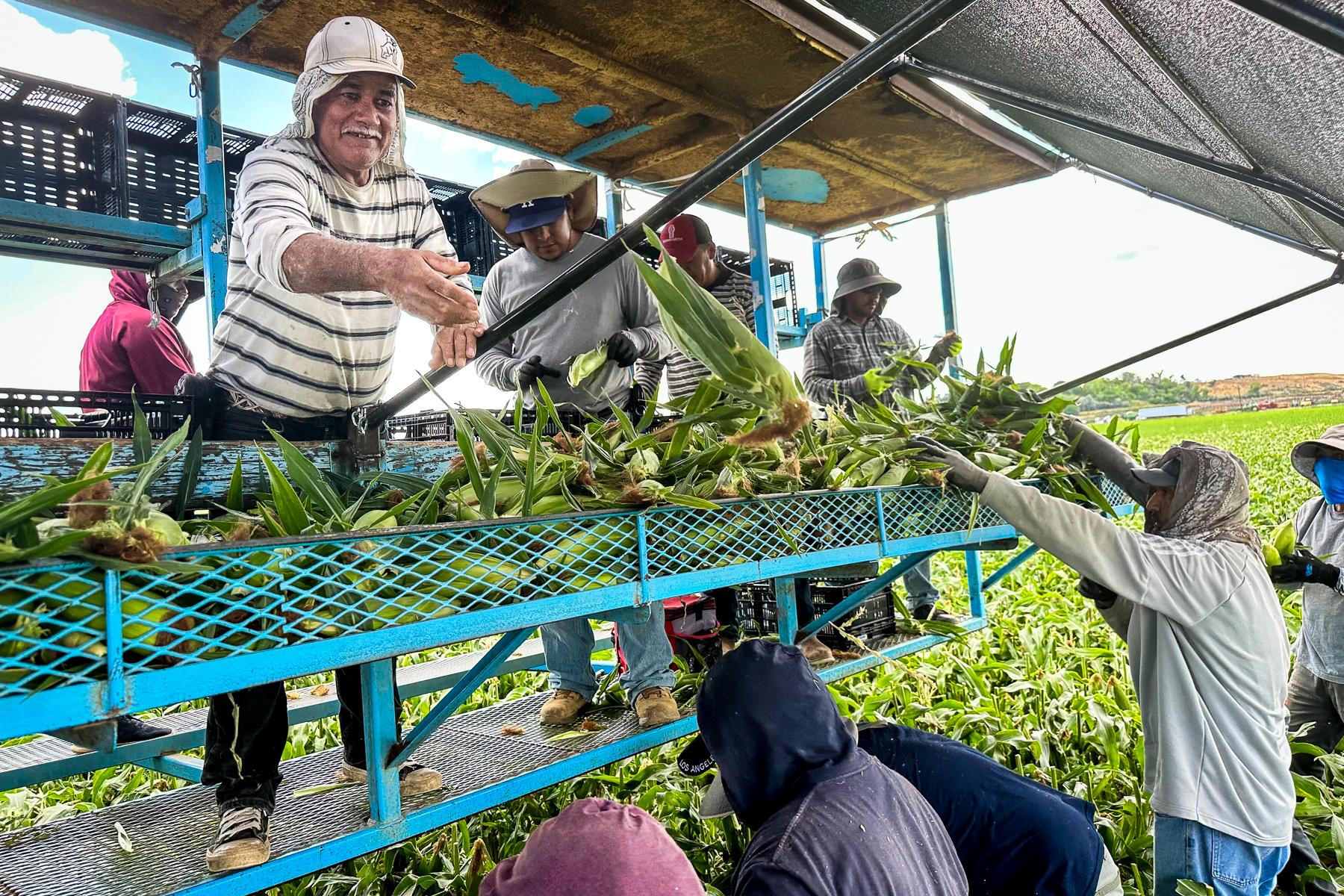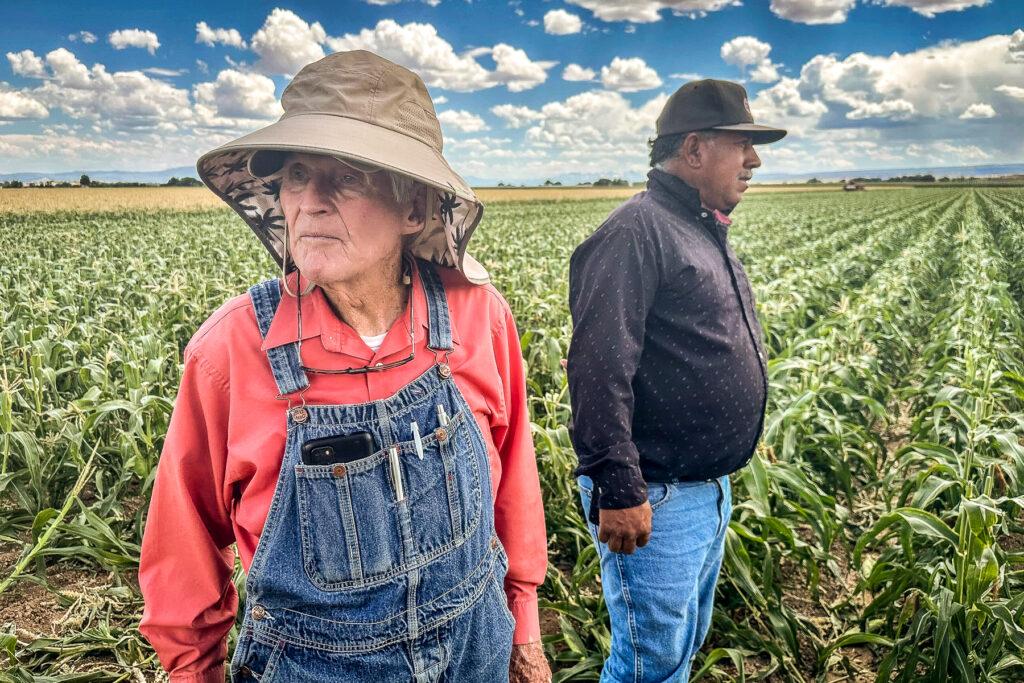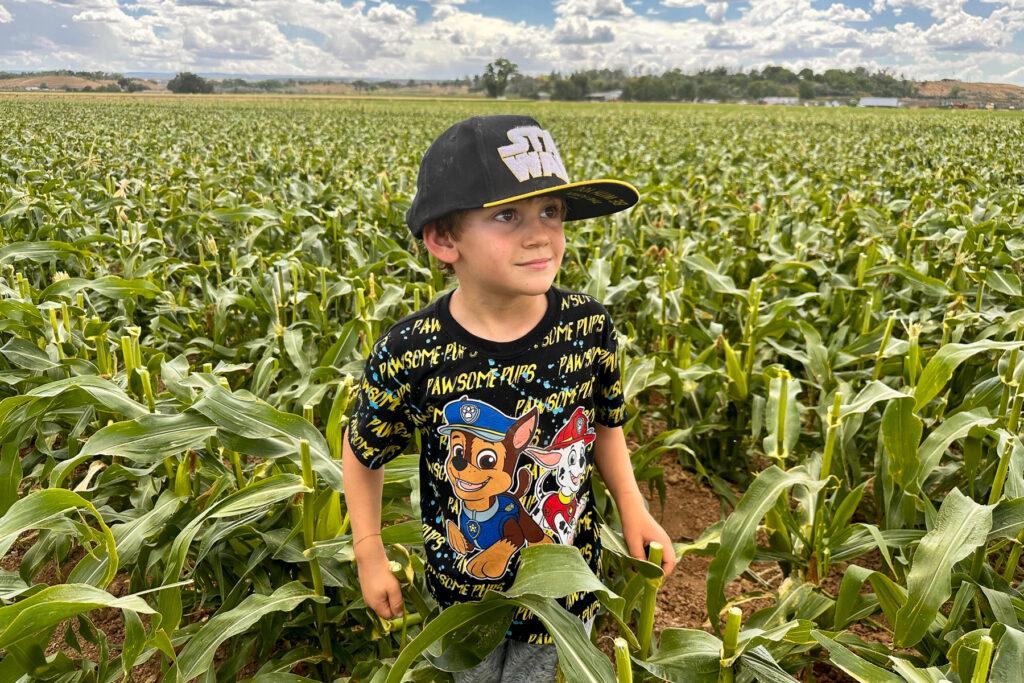
In the baking sun, under big, cotton-ball clouds, farmer John Harold shucked an ear of the corn that made him — and the small town of Olathe, Colorado — famous.
“You can see by the marks here that the bird went after it,” he said, holding up an ear of Olathe Sweet sweet corn, the corn so enmeshed with him that he holds its trademark.
At the top, a few kernels were missing, replaced by brown craters, but otherwise it was a beauty: satin yellow pearls, a halo of green silk. It was perfectly edible but not sellable because of the damage made by a small worm, a worm that was long gone. All around Harold were rows upon rows of corn, all of which had to be checked before a single ear could be picked.
In some fields, more than 40 percent of the ears have worm damage. But standing there in his jean overalls and big sun hat, Harold still had his humor.
“I think the worms this year are on Viagra,” he said, laughing. “They’re breeding pretty quick!”
Harold has been farming this corn since the early 1980s, and in that time Olathe’s sweet corn harvest has become the stuff of legend, trumpeted as the sweetest part of Colorado summers. Usually starting in July and lasting into September, grocery stores loudly announce its return. Fancy restaurants unveil seasonal sweet corn-forward dishes. This corn even has its own festival.
Olathe sweet corn’s enticing, earthy flavor is so popular it ships to more than 30 other states, too.
But now, a bug known as the cornsilk earworm is threatening all that.
As of late last week, Harold’s business, the Tuxedo Corn Company, had shipped only about 30,000 boxes of sweet corn. In a normal year, it would be about five times as much, 150,000.
Many worms. It's ugly.
As Harold chatted with his longtime foreman, Samuel Jimenez, they laughed but didn’t sugarcoat a thing. Neither has ever seen anything like this.
“Muchos gusanos,” Jimenez told Harold.
“Muy feo,” Harold said.
Many worms. It’s ugly.
Harold walked through one of many fields littered with corn casualties, the cast-offs lying in the dirt after workers checked each ear. They’ve been doing that before they even start picking. So it takes much longer to harvest. It’s taking so long, in fact, that a good portion of Harold’s 1,600 acres won’t even get picked this season.

“That’s what we’re trying to figure out: Is there a better, faster way to do what we’ve been doing?” he said. “Because there’s no way we can do what we’re doing by running at about 15 percent of capacity.”
Harold didn’t want to talk money, but the losses are huge — and not just for his company, the biggest sweet corn producer in the state.
Dozens of other sweet corn farmers in the area are fighting the same tiny foe.
Desperate for answers
Melissa Schreiner, an entomologist with Colorado State University Extension, calls the worm’s effect “almost indescribable.”
“There are folks desperate for answers, including myself,” she said.
Schreiner and her research associate have been pulling 80-hour weeks trying to figure out how the worm problem came to be — and how to combat it.
She has heard the theories, including the lack of a spring freeze to kill off the moths that lay the worms, a hot July spurring them on and winds pushing in more moths. Plus, she knows the usual pesticides are not working. It’s a perfect storm creating imperfections.
As Harold has said, there’s nothing wrong with this corn.
“It’s just that there’s the presence of a pest in there,” Schreiner said. “And I think consumers could have a lot of impact. They could help save the sweet corn community if they weren’t as picky.”
But a huge culture shift like that would take time, and that’s a resource these farmers don’t have. A new state law requiring overtime pay for farm workers for the first time is adding more pressure. So is the continued heat.
Harold finds the term “climate change” too political to use but believes it’s happening.
“There’s no question in my mind,” he said, before letting out a resigned sigh. “But still, haven’t convinced a lot of people."
Farmers swing between optimism and pessimism
Even with all these factors pressing him, as recently as about a week and a half ago, Harold still sounded optimistic about defeating these worms.
“I guess it’s just a natural gene in a farmer,” he said, with an easy chuckle, “that no matter what happens, you just seem convinced as a farmer you can figure it out.”
But just a few days later, we spoke again, Harold on his cell phone, pulled off on the side of the road, surrounded by the farmland that produces this beloved corn.
“We may just quit,” he said, plainly.
I know. Quit.
Harold told me he’s giving it 40 days to try out new methods, to harvest, to kill moths, to try and salvage this season. Otherwise, he might not plant for next year.
“So there’s time, but that time’s running out,” he said.
It was so thudding and stark, that I kept calling him over the next several days, waiting for something to change. And it did, a little. A letter he wrote to U.S. Sen. Michael Bennet got traction, connecting Harold with federal and state agencies.

When Harold hosted an in-person crisis meeting with growers, virtual attendees included staff from the U.S. Department of Agriculture, Colorado’s agriculture department, Bennet’s office, Colorado’s agriculture commissioner and many others.
“There’s still hope,” Harold said, over one of our phone calls. “The problem is, I’m not sure it’s very science-based.”
Hope often isn’t. Harold explained a lot of that hope comes from the other sweet corn farmers, the younger farmers, including his own son, David.
In the emergency, an opportunity for education and change
On one level, this emergency problem-solving is what farming “is all about,” David Harold said. He’s actually been thinking about and planning for this kind of large-scale issue for years.
“This is what we've been told. You know, it's gonna get harder. The pests are gonna get tougher. The water situation's gonna get worse,” he said.
Harold thinks that all crops are vulnerable to these changes. And this second-generation sweet corn grower is trying to see this as an opportunity, a chance to educate consumers, talk to legislators — to build farming for the future into something better.
“Robust, smart, healthy-for-our-community agriculture,” he called it.
A world where maybe produce costs more, is valued more and doesn’t have to look perfect as long as it tastes good. An industry in which farmers can pay overtime easier.
The younger Harold imagines a new kind of food system “that people can buy into, support, go to the grocery store and feel comfortable and happy that what they're paying for is worth it.”
As he looks to the far future, he’s also looking to next summer, and believes you’ll still be able to buy his family’s corn. So far, he’s planning to plant.
As for this year, workers continue to hand-pick those tender ears, pack them in ice and send them off to stores. It’s the same sweet corn that put Olathe on the map — just a whole lot less of it.









